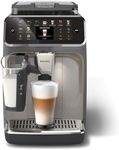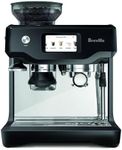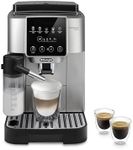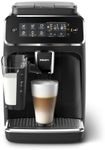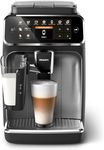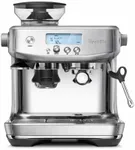Buying Guide for the Best Espresso Machines With Grinders
Choosing an espresso machine with a built-in grinder can make your coffee routine much easier and more enjoyable. These machines combine two essential steps—grinding beans and brewing espresso—into one device, saving space and time. When shopping for one, it's important to understand the main features and how they affect your daily use. By focusing on the key specifications, you can find a machine that matches your coffee preferences, kitchen space, and how hands-on you want to be with the brewing process.Grinder TypeThe grinder is responsible for turning coffee beans into grounds, and its type affects the taste and consistency of your espresso. The two main types are blade and burr grinders. Blade grinders are usually less expensive but can produce uneven grounds, which may lead to inconsistent espresso. Burr grinders, on the other hand, crush beans between two surfaces for a more uniform grind, resulting in better flavor extraction. If you care about getting the best taste and consistency, a burr grinder is generally preferred. For those who just want convenience and aren't too picky about flavor nuances, a blade grinder might be sufficient.
Grind Size SettingsGrind size settings let you control how fine or coarse the coffee grounds are. This is important because espresso requires a fine grind for proper extraction. Machines with more grind size options give you greater control over the taste and strength of your espresso. If you like experimenting with different beans or want to fine-tune your espresso, look for a machine with many grind settings. If you prefer simplicity and just want a good cup without fuss, a machine with a few preset options will do the job.
Brewing PressureBrewing pressure, measured in bars, is the force used to push hot water through the coffee grounds. Standard espresso is made at around 9 bars of pressure, but machines often advertise higher maximum pressures. While higher pressure can help extract more flavor, anything above 15 bars is usually unnecessary for home use. If you want authentic espresso, make sure the machine can consistently deliver at least 9 bars. For most users, a machine in the 9–15 bar range is ideal.
Water Tank CapacityThe water tank holds the water used for brewing and steaming. A larger tank means you can make more drinks before needing to refill, which is convenient if you make several cups a day or entertain guests. Smaller tanks are fine for occasional use or if you have limited counter space. Think about how many espressos you typically make in a day to decide what size is right for you.
Milk Frothing CapabilityIf you enjoy milk-based drinks like cappuccinos or lattes, the machine’s milk frothing system is important. Some machines have manual steam wands, which let you control the frothing process and create café-style microfoam, but require some practice. Others have automatic frothers that make the process easier but offer less control. If you want to learn barista skills and enjoy customizing your drinks, a manual wand is a good choice. If you prefer convenience and consistency, look for an automatic frother.
Ease of CleaningEspresso machines with grinders can be more complex to clean due to the extra parts. Some have removable brew groups and drip trays, making cleaning easier, while others offer automatic cleaning cycles. If you want to minimize maintenance, look for features like removable parts and self-cleaning functions. If you don’t mind a bit of hands-on cleaning, you can focus more on other features.
Size and FootprintThese machines can be bulky, especially with a built-in grinder. Consider the space available on your kitchen counter and the height under your cabinets. If you have limited space, look for a more compact model. If space isn’t an issue, you can choose a larger machine with more features.
